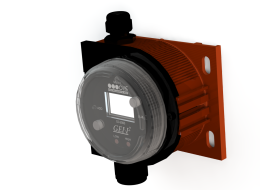News
Correct Placement of Methane Gas Detectors can Save Lives

Methane is a natural component of air and everyone is exposed to low levels of methane when they breathe in the air outside. But methane is an occupational hazard in certain industries where it is likely to occur in higher concentrations, such as wastewater treatment facilities, biogas plants, landfills, oil and gas operations, and mining operations, as well as other industries where workers work in confined spaces underground or in poorly ventilated buildings where methane gas can accumulate. Managers of sites where methane poses a danger need to be aware of the associated hazard risks, and monitor methane levels regularly to ensure worker safety and to prevent methane gas from methane migrating off site, potentially posing a risk to neighboring communities.
Explosion Hazard
Not only does methane have no odor or color, it is extremely flammable and can be explosive when mixed with air at concentrations of between 5-15% of the total air volume. It thus poses a substantial occupational health and safety risk to workers.
Hazardous areas should be clearly marked with warning signs alerting workers of the danger, as a spark from a match or power tool can trigger an explosion. Workers should refrain from smoking in ‘no smoking’ zones and only light up in designated areas where it is safe to do so, ensuring cigarette butts are extinguished and disposed of responsibly. Workers should also use caution when working with power tools in high risk areas by controlling static electricity, checking methane levels with a combustible gas detector before using any machinery that could potentially trigger an explosion, and opting for non-sparking tools and machinery wherever possible.
Asphyxiation Hazard
Besides the risk of fire or explosion, methane is an asphyxiant that can displace oxygen. Workers who are exposed to high concentrations of methane in a confined space can suffer asphyxiation due to oxygen deprivation if oxygen is displaced. Initial symptoms resulting from exposure include headaches, dizziness, nausea, vomiting, general weakness and fatigue, and loss of muscular coordination. Prolonged exposure can result in loss of consciousness and death due to suffocation.
Risk of Methane Gas Migrating Offsite
Should methane escape into the sub-surface layers of the soil, it has the potential to migrate both horizontally and vertically through the soil, where it can enter stormwater drains, sewers, or basements of buildings through holes or cracks in the floor or walls. Rogue methane emissions that have been released to the atmosphere can enter into buildings through ventilations systems, windows or doors, and can accumulate in areas that are poorly ventilated. In confined areas methane gas poses an explosion hazard and puts workers and people living in neighboring communities at risk of asphyxiation.
Detecting Methane Gas in Indoor Spaces
Rooms in buildings that are susceptible to methane accumulation should have a methane detector installed. Having an early warning system will allow workers to take additional safety measures, such as put on an oxygen mask or refrain from using power tools that could spark and trigger an explosion. This early warning system will also enable them to alert managerial staff when methane levels are higher than normal, so that they can implement the necessary measures to reduce the risk to both staff on site and neighboring communities.
Tips for Using Methane Gas Detection Tools
Having the correct tool to monitor methane is paramount to preventing accidents in high risk areas, but we also need to have a clear understanding of the basic science of gas monitoring and detection to ensure these are effective at preventing accidents and saving lives. For example, while some gases are heavy and more inclined to sink, methane gas is light and tends to rise. Because methane tends to rise above air, in buildings, methane concentrations tend to be higher nearer the ceiling. To avoid methane going undetected, it is important that methane is monitored at the location where it is more likely to accumulate, including high levels that may not normally be checked by hand-held gas monitors. Methane gas detectors should therefore be placed near the ceiling, leaving a distance of at least 6 inches from the ceiling, while also avoiding dead air spaces, e.g. corners. Carbon monoxide on the other hand is only around 3% lighter than air, so is more inclined to disperse evenly in all directions around the room at normal room temperature. Therefore CO detector alarms should be installed within 40 feet of any sleeping areas, especially if these are located near fire places, furnaces or hot water heaters.
It is important to note that while gas detectors are important safety instruments, they have their limitations if not used/installed correctly. Optimal placement of gas detectors is crucial to preventing accidents and saving lives.


